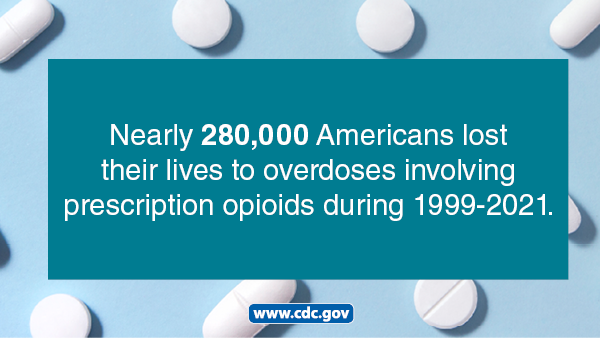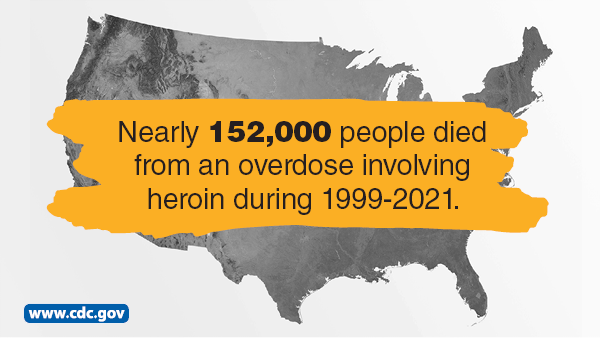Opioid Overdose
Prescription opioids are often used to treat chronic and acute pain and, when used appropriately, can be an important component of treatment. However, serious risks are associated with their use, and it is essential to carefully consider the risks of using prescription opioids alongside their benefits.
Millions of Americans suffer from pain and are often prescribed opioids to treat their conditions. However, the dangers of prescription misuse, opioid use disorder, and overdose have been a growing problem throughout the United States.

Since the 1990s, when the amount of opioids prescribed to patients began to grow, the number of overdoses and deaths from prescription opioids has also increased. Even as the amount of opioids prescribed and sold for pain has increased, the amount of pain that Americans report has not similarly changed.
From 1999 to 2021, nearly 280,000 people died in the United States from overdoses involving prescription opioids. The number of drug overdose deaths involving prescription opioids in 2021 was nearly five times the number in 1999.1
In 2021, 45 people died each day from a prescription opioid overdose, totaling nearly 17,000 deaths.1 Prescription opioids were involved in nearly 21% of all opioid overdose deaths in 2021.

Heroin-involved overdose death rates decreased by nearly 32% from 2020 to 2021. However, in 2021 more than 9,000 people died from a heroin overdose in the United States, a rate of nearly three deaths for every 100,000 Americans. The number of heroin-involved overdose deaths in 2021 was three times the number in 2010, and over 11% of all opioid deaths involved heroin.1
In 2021, nearly 71,000 drug overdose deaths involving synthetic opioids (other than methadone) occurred in the United States, which is more deaths than from any other type of opioid. Synthetic opioid-involved death rates increased by over 22% from 2020 to 2021 and accounted for nearly 88% of all opioid-involved deaths in 2021. The number of overdose deaths involving synthetic opioids in 2021 was nearly 23 times the number in 2013.1
Previous reports have indicated that increases in synthetic opioid-involved deaths have been associated with the number of drug submissions obtained by law enforcement that test positive for fentanyl, but not with fentanyl prescribing rates. These reports indicate that increases in synthetic opioid-involved deaths are being driven by increases in fentanyl-involved overdose deaths, and the source of the fentanyl is more likely to be illegally made than pharmaceutical.2,3,4
There are also fentanyl analogs, such as acetylfentanyl, furanylfentanyl, and carfentanil, which are similar in chemical structure to fentanyl but not routinely detected because specialized toxicology testing is required. Recent surveillance has also identified other emerging synthetic opioids, like U-47700.5 Estimates of the potency of fentanyl analogs vary from less potent than fentanyl to much more potent than fentanyl, but there is some uncertainty because potency of illegally made fentanyl analogs has not been evaluated in humans. Carfentanil, the most potent fentanyl analog detected in the U.S., is estimated to be 10,000 times more potent than morphine. 5,6
Fentanyl Contamination of Other Drugs Is Increasing Overdose Risk
- A synthetic (man-made) opioid 50xmore potent than heroin and 100x more potent than morphine
- Prescribed in the form of transdermal patches, tablets, lozenges, or nasal sprays
- Can also be illegally made (illegally made fentanyl or IMF) and mixed into other drugs like heroin or cocaine, pressed into pills, co-used, or used alone
The risks of fentanyl contamination of illegal drugs are a growing concern, as this can lead to an increase in overdose deaths among people who may or may not be aware that their drugs include this deadly additive, and among people who have not used opioids before, and thus are at greater risk for overdose.
Fentanyl is approximately 50 times as potent as heroin. Fentanyl and fentanyl analogs are being mixed into counterfeit opioid pills, heroin, cocaine, and methamphetamine. Illegally made fentanyl (IMF) is likely contributing to deaths involving these other substances.
People who only use non-opioid drugs are more likely to overdose if they are exposed to drugs mixed with opioids, including fentanyl. This fentanyl contamination of other drugs may contribute to increased risk for overdose, as those misusing other drugs can be exposed to drug products that vary in potency, including some extremely strong products.
- In a 10-state study, almost 57% of people who died from an overdose tested positive for fentanyl and fentanyl analogs also tested positive for cocaine, methamphetamine, or heroin.6
- More than half of opioid overdose deaths in 10 states studied tested positive for fentanyl. Northeastern states and Missouri reported the highest percentage of opioid overdose deaths involving fentanyl, followed by Midwestern and Southern states.6
- The detection of fentanyl analogs in >10% of opioid overdoses in four states raises the concern that fentanyl analogs are rapidly becoming part of illicit opioid markets in multiple states.7
There have been an alarming number of recent deaths involving fentanyl analogs in certain states. Carfentanil, which is the most potent fentanyl analog detected in the United States, is responsible for the largest number of these deaths. For example, during July 2016–June 2017, among 11,045 opioid overdose deaths examined in 10 states, more than 20% of those who died from an opioid overdose tested positive for any fentanyl analog, and more than 11% tested positive for carfentanil.9
Beginning in 2013, there were significant increases in deaths involving synthetic opioids – particularly those involving IMF. Individuals using substances may not know if or when substances may be contaminated with fentanyl, so they need to be aware of the risks. Good Samaritan Laws assist eyewitnesses or bystanders in seeking help if they witness an overdose, as these people know that they can safely call for help to ensure a rapid emergency response. Overdoses can be reversed with naloxone, either administered by bystanders or by first responders. However, a higher dose, or multiple number of doses per overdose event may be required to revive a patient due to the high potency of drugs currently in the drug supply.9,10
The Drug Enforcement Administration’s (DEA) National Forensic Laboratory Information System (NFLIS) collects fentanyl encounters data on drug chemistry analysis from drugs seized during law enforcement operations.
- Wide-ranging online data for epidemiologic research (WONDER). Atlanta, GA: CDC, National Center for Health Statistics; 2022. Available at http://wonder.cdc.gov.
- Gladden RM, Martinez P, Seth P. Fentanyl law enforcement submissions and increases in synthetic opioid-Involved overdose deaths – 27 states, 2013-2014. Morb Mortal Wkly Rep. 2016;65(33):837-43.
- Peterson AB, Gladden RM, Delcher C, Spies E, Garcia-Williams A, Wang Y, et al. Increases in fentanyl-related overdose deaths – Florida and Ohio, 2013-2015.Morb Mortal Wkly Rep. 2016;65(33):844-9.
- O’Donnell JK, Gladden RM, Seth P. Trends in Deaths Involving Heroin and Synthetic Opioids Excluding Methadone, and Law Enforcement Drug Product Reports, by Census Region — United States, 2006–2015. MMWR Morb Mortal Wkly Rep 2017;66:897–903.
- O’Donnell JK, Halpin J, Mattson CL, Goldberger BA, Gladden RM. Deaths Involving Fentanyl, Fentanyl Analogs, and U-47700 — 10 States, July–December 2016. MMWR Morb Mortal Wkly Rep 2017;66:1197–1202.
- O’Donnell J, Gladden RM, Mattson CL, Kariisa M. Notes from the Field: Overdose Deaths with Carfentanil and Other Fentanyl Analogs Detected – 10 States, July 2016-June 2017. MMWR Morb Mortal Wkly Rep. July 2018. 67(27);767–768.
- O’Donnell JK, Halpin J, Mattson CL, Goldberger BA, Gladden RM. Deaths involving fentanyl, fentanyl analogs, and U-47700 — 10 states, July 1–December 31, 2016.MMWR Morb Mortal Wkly Rep 2017;66:1197–1202.
- O’Donnell J, Gladden RM, Mattson CL, Kariisa M. Notes from the Field: Overdose Deaths with Carfentanil and Other Fentanyl Analogs Detected – 10 States, July 2016-June 2017. MMWR Morb Mortal Wkly Rep. July 2018. 67(27);767–768
- Centers for Disease Control and Prevention. CDC Health Advisory: Influx of Fentanyl-laced Counterfeit Pills and Toxic Fentanyl-related Compounds Further Increases Risk of Fentanyl-related Overdose and Fatalities. August 25, 2016. https://emergency.cdc.gov/han/han00395.asp
- Centers for Disease Control and Prevention. CDC Health Advisory: Rising Numbers of Deaths Involving Fentanyl and Fentanyl Analogs, Including Carfentanil, and Increased Usage and Mixing with Non-opioids. HAN Health Advisory, July 11, 2018.

